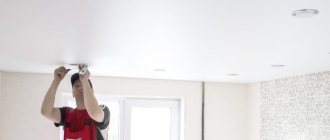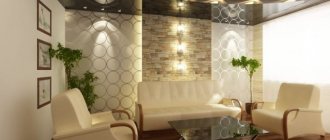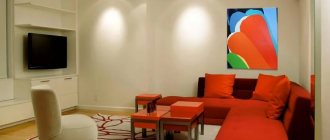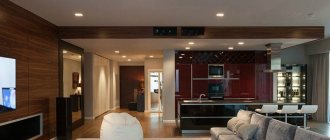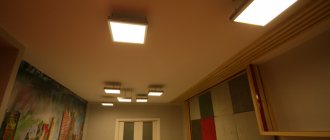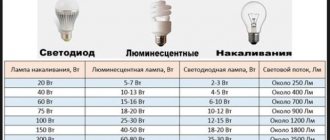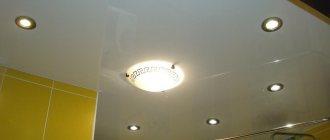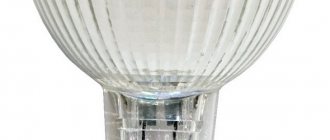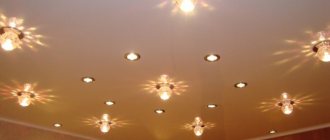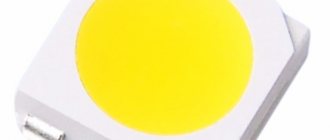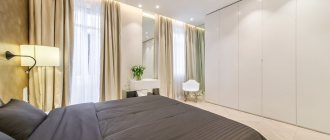assets/from_origin/upload/resize_cache/iblock/40d/600_450_2/40dc1b1566553eed3fd9879627ebb6e0.jpg From this article you will learn:
- How to prepare a ceiling for installing lamps in plasterboard
- How to choose the right spotlights for installation in drywall
- What are the stages of installing spotlights in drywall?
In modern interior design, the use of spotlights (spots) has become a common and effective solution. The main advantages of this type of lamps are ease of installation and stylish appearance. Installing spotlights in drywall will not take much time and will not require professional skills.
Preparation
Properly organized room lighting provides a pleasant and comfortable pastime, helps decorate the interior or create effective visibility in the work area. However, to achieve high-quality lighting effects, it is important to correctly select the necessary materials, tools, equipment, plan the location, etc. First, let's look at the possible options for tools that may be useful to you for carrying out activities for installing spotlights.
Required tools and materials
In each specific situation, the installation of a spotlight can differ significantly, since the process is associated with the characteristics of the ceiling structures, the stages of repair work and the tools and devices available.
The most relevant tools are for drilling holes in drywall; this process can be carried out using:
- A special flexible crown for working on plasterboard is the best option, as it is designed specifically for plasterboard ceilings. The set contains several ring-shaped files of different diameters, which are inserted into the drill attachment.
Flexible crowns
- Circular tile drill (ballerina) , despite the fact that their direct purpose is to work on ceramic surfaces, they do an excellent job with drywall. A significant advantage of such a drill attachment is the ability to set the center of the hole with fairly high accuracy.
Crown on tiles
- Jigsaw - working with an automatic blade is more difficult than with previous attachments, but it is still possible to make a hole close to round in shape.
Using a jigsaw
- Drill bits - with its help you can drill a fairly large number of holes in a circle, and break out the inside with your fingers.
- A hacksaw blade or a stationery knife are the most difficult options, since all the work will have to be done manually.
You can take any of the above tools for working on drywall that you have on hand. Most of them can be driven automatically using a drill, a screwdriver, or a hammer drill with a drill function.
To connect spotlights you will need connecting wires or cable. Connecting wires to the lamp can be done using soldering, terminals or sleeve crimping. When working with cable and wire products, you may also need pliers, wire cutters, and pliers to remove insulation. To tighten/unscrew the bolts, you must use slotted and Phillips screwdrivers.
Spot lamp selection
The very concept of a spotlight comes from the English lexicon, where they are called spot. In domestic usage, such lighting devices are called soffits, spotlights or spots; the main difference between such lighting sources is their local location and the same effect. However, the variety of their shapes, design features and design requires a responsible approach to choosing a spotlight model for installation in a ceiling frame. The division is made according to a number of factors, so below we will consider them all in turn.
Based on the type of lamps installed, lighting spots are divided into:
- Incandescent lamps are the simplest option, but are characterized by very low efficiency, only about 5% of the electricity is spent on lighting and poor light output of 8 - 10 Lm/W;
- Halogen lamps - have slightly better light output than incandescent light bulbs from 12 to 18 Lm/W, but are not easy to touch with bare hands;
- Fluorescent light bulbs are a category of gas-discharge lamps that have a high light output of 40 to 60 Lm/W, but contain toxic mercury, which is easily absorbed into drywall. They belong to the category of energy-saving lamps, therefore, despite their high cost, they can significantly save energy.
- LED light bulbs are the most effective, as they can provide from 90 to 120 Lm/W and are completely safe for humans. They also fall into the category of energy-saving devices. LED lamps are often used for LED lighting of premises.
For spotlights, the most profitable are fluorescent and LED lamps. They generate relatively little heat, consume little electricity, and can provide a wide range of color temperatures - from warm to cold spectrum.
By type of base - there is quite a wide variety of connection options, but in spotlights they are used with base G, E and non-separable models. In the latter, the light bulb is not separated from the lamp; they use built-in lamps and the entire lamp must be replaced.
By type of base
In terms of overall dimensions, they can have different diameters and heights, which must be taken into account in relation to the size of the plasterboard boards in which they will be installed. The height of the ceiling light should be less than the space in the niche behind the drywall so that it fits freely in the hole.
Based on the method of arrangement, recessed and surface-mounted ceiling lamps are distinguished. The first of them are completely hidden under drywall, overhead devices remain outside, and the mounting method is identical to that of a chandelier.
Built-in and overhead
According to their design, they can be stationary or rotary, single or block. Stationary spotlights illuminate only a strictly defined area, while rotary spotlights can change the position of the illuminated area. Single ones contain only one point of the lighting device, while block ones contain several at once in one housing.
Stationary and rotary
Installation Requirements
There are no general requirements for installing spotlights in plasterboard, but there are recommendations regarding some parameters. Firstly, built-in lamps must provide good visibility or local illumination in a certain area. Secondly, the choice of installation location and technical parameters must be consistent with other elements of the lighting system - hanging chandeliers, LED strips, sconces, etc.
Thirdly, it is recommended to maintain the distances between spotlights in the following ratios:
- If lamps are mounted in rows, then there should be no more than 1 m between them;
- Within one row, the distance between spotlights should not exceed 1.5 m;
- If there are several rows, then the point devices should be staggered relative to each other;
- The distance from built-in spots to walls or windows should be at least 0.5 - 0.6 m.
How to hide LED strip
There are many ways to install diode strips; very often they are used in multi-tiered ceiling structures to emphasize each fragment. But even if you have an ordinary flat ceiling, you can also play with it in an interesting way. You can install such lighting even alone. In this case, you will need a special wide cornice for LED lighting.
Let's take a closer look at the algorithm of actions:
- Using a building level, mark the line for the location of the cornice, 10 cm from the ceiling.
- Glue the cornice using liquid nails, titanium or acrylic putty.
- Carefully glue the joints between the cornice strips, especially in the corners.
- Run the wiring into the cornice and connect the power supply that needs to be secured to the wall.
- Connect the LED strip to power. If you need to connect more than 5 meters of tape, then each section is connected to the power supply in parallel.
Selecting an installation location and mounting holes
Installation of spotlights is carried out in accordance with the characteristics of plasterboard structures and the planned quantity. The simplest option is considered to be the option during installation of the frame, when both the placement of electrical wiring and the location of the profile can be adjusted. If the ceiling tiles have already been installed and the finishing work has been completed, then the location will be selected in accordance with the type of structure and installation method.
For recessed spotlights, it is necessary to select a free space in the drywall where there is no metal profile, otherwise you will have to change the sheet of drywall and re-carry out the finishing work. If the marks on the places where the profile was laid have not been preserved, then you can use a magnet to find them.
Profile in hole
If the lamp is overhead, then the installation location is chosen, as for the location of the chandelier. In this case, you can use two methods of fastening: using metal screws or using butterfly dowels. For the first option, select a place where there is a profile behind the drywall. In the second case, the installation location is not tied to the profile; the butterfly dowel is installed under any conditions.
Layout
The principle of installing point lighting devices has no strict boundaries. The location on the suspended structure is determined based on your needs for room illumination or the creation of decorative lighting; perhaps the diagram should become a figure for decorating a plasterboard ceiling. Below are commonly used luminaire placement options:
Lamp layout diagrams
Arrangement options for LED spotlights for plasterboard ceilings
The installation scheme and placement of lighting points on plasterboard depends only on the design of the ceiling. This could be installing lamps in a chain around the perimeter of the room. For such a scheme, stationary unregulated lamps are used.
A fairly popular scheme is in which the ceiling lights are distributed in several groups. In this case, the main part of the light flux is directed not vertically, but at an angle towards the wall.
This is called reflected flux lighting. Very convenient if you need to create an atmosphere of comfort in the room.
Adjustable lamps with LED reflectors are installed in the kitchen and auxiliary rooms. They are most convenient for conditions where they work and require high brightness lighting.
Installation process step by step
To install spotlights in drywall, you will need to perform the following sequence of actions:
- Apply markings for future installation locations on the plasterboard structure. It is advisable to use measuring devices to ensure that the hole is centered.
- Select the diameter of the drill bit according to the diameter of the spots. It is desirable that it be a little larger, then the lamp will easily fit into the diameter of the hole.
- Turn off the power supply to the electrical network at the input panel if the connection and installation of electrical wiring has already been completed. If the power supply system for spotlights is not yet connected, you can skip this point.
- Drill a hole in the drywall or make one using any of the methods described above.
Make a hole in drywall
- Pull the power wires out through the holes and clean their edges.
Get the wires
- Make an electrical connection to the spotlight to the wiring line.
Connecting the lamp to the wiring
- Hide the wiring in the frame and install the soffit in the drywall, secure it with spring fasteners.
- Install an LED or fluorescent lamp into the socket. If necessary, secure with a spring pin.
Secure the lamp with a pin
Rules and tips
Before installing spotlights, it is advisable to familiarize yourself with the basic tips and rules developed by installation specialists:
- If you want to regulate the power of the light flux, then before installing the spots you need to select dimmable LED lamps and the same switch.
- Never use twists for electrical connections; this is an extremely dangerous option.
- If there are suspended ceilings in close proximity to the spotlight, carefully select the power of the light bulb, as the film may be deformed.
- When installing halogen lamps in a spotlight, do not touch the bulb with your bare fingers - this will shorten its service life.
- If you need to power spotlights from low voltage, they are connected via a power supply or transformer. The power of the transformer or unit is selected depending on the power of the lamps.
- In cases where the installation of a point device requires special care, the mounting springs are tightened with wire, which is cut after installation.
How to calculate a transformer
Transformer is a device that transforms 220V voltage to 12V voltage. If you use 12 volt light bulbs, be sure to install a step-down transformer.
We choose it by power. To calculate the power of the installed light bulbs, we multiply by their number and add 20% - the power reserve.
There are induction and electronic transformers. Induction is a cheaper option, although more reliable. Electronic ones are more expensive, but they are lighter in weight. The wire leading to the transformer should be less than two meters to avoid power loss.
How many lamps should I choose per room? We calculate based on the fact that one square meter requires illumination of at least 20 watts.
